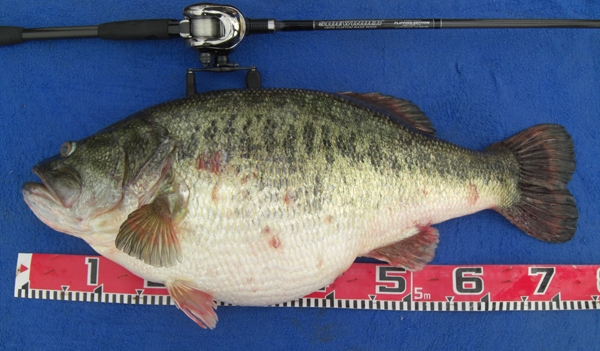A Fishing World Record You Can Break | IFGA Length Record For Largemouth Bass Is Only 25.6 Inches!

Manabu Kurita’s World Record Bass from 2009
Updated February 23, 2020, originally posted March 7, 2017.
Early Spring of 2011 – the International Game and Fish Association (IGFA) created a “length” world record category to go along with the well established “weight” world categories for many freshwater and saltwater fish species. Instead of having to weigh a fish on land, this new category requires anglers to return the fish to the water alive after measurement. The IGFA All-Tackle Length category encompasses 64 freshwater and 73 saltwater species.
Largemouth Bass Length World Record

Lance Jones with his 65cm record bass on Lake Jeffery Florida – photo via Facebook
While the largemouth bass weight record (22+ pounds) is likely out of reach for most of us – as of February 2020, when this article was updated, the world record bass in the length category is only 25.59 inches (65cm)!
We know that largemouth bass have been documented to be up to 30-32 inches in length, however, a fish of those lengths has not been caught and documented in the proper way as to receive the IGFA World Record certification. As it currently stands, George Coniglio from Mission Viejo, California, USA and Lance Jones from Lake Jeffery, Florida, USA currently hold a TIE for the All-Tackle Length Record for Largemouth Bass with a confirmed and documented catch from May 13, 2015 for George and a confirmed catch on April 24, 2018 for Lance that both measured exactly 65 cm in length. According to the Texas Parks and Wildlife (TPWD) length to weight conversion charts – at bass that is 25-26 inches in length is typically between 9-12 pounds. Catching a double-digit weighing bass is certainly a once in a lifetime occurrence for many anglers – however, it is not all that uncommon in the fishing world.
Be Prepared

Illustration © TPWD
You can only be awarded the World Record if you follow all the proper measuring rules and documentation procedures. To begin with, you’ll need the official IGFA World Record Measuring Device ($49.95). You’ll need to make sure that your catch is at least 2cm longer than the existing record (or it will be considered a tie). Next, make sure to take a picture of 1.) the full length of the fish on the measure device. 2.) a close up showing the position of the fish’s nose and tail on the measuring device. 3.) the angler and the fish. 4.) the rod and reel used to make the catch. You’ll also want to make a note of the type and pound test of the fishing line you used.
Good To Know
The IGFA highly recommends that you have a witness present. If not, you may be disqualified if any questions about the catch arise. Also, a record claim from the U.S. must be submitted within 60 days of the date of catch, while fish caught in other waters must be submitted within 3 months.












